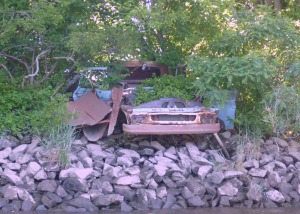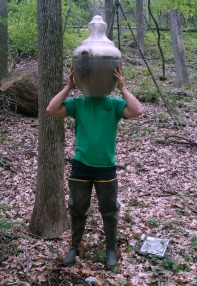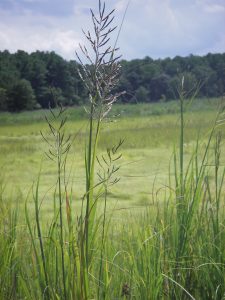
Facebook Twitter Instagram YouTube
Written on: August 19th, 2016 in Wetland Assessments

Old abandoned car along Christina River.
People have been creators of some amazing inventions throughout history: wheels, cars, electricity, plastics and more! But what happens to these creations when they have outlived their use or are no longer wanted? You’re probably guessing that they end up in places like the dump, or antique stores or junk yards. But, would you believe that these unwanted items also end up left, dumped, or washed into our wetlands and their buffers?
Wetlands have the natural ability to clean and purify our waters by trapping excess sediments and nutrients, and they also have the unfortunate ability to trap our trash. That trash then prevents the wetland from being able to function fully, which isn’t good for us and the health of our waters.

WMAP staff with lamp post globe.
We here at the Wetland Monitoring and Assessment Program, run into quite a few unique items as we walk through and assess Delaware’s wetlands. So, we thought we would put together a short list to show the array of man-made items we have found across Delaware, and let you ponder whether you think these items are “trash” or “treasures”.
From cool to creepy to junk, here are some of the items we have run across: golf balls, baby doll heads, Barbie’s, trash cans, BB gun, barrels, buoys, lamp post shades, glass bottles, crab pots, paddle boats, tires, cars, cranes and signs. Click here for more photos.
Moral of this story; if you see trash in or near a wetland, help a wetland out, and pick it up to properly dispose of it at the dump or antique store (Who knows, you might even make a little money.). As the saying goes, one man’s trash is another man’s treasure.
For more information on illegal trash dumping in Delaware or to report illegal dumping, please visit Delaware TrashStoppers.
Written on: August 4th, 2016 in Wetland Assessments
By Tess Strayer, DNREC’s Wetland Monitoring and Assessment Program Summer 2016 Summer Seasonal
Growing up, I spent the majority of my childhood outdoors with friends, family, and the occasional wild animal. Whether it was hiking, biking, fishing or playing we were constantly exploring, thus you would think my outdoor experience would help better prepare me for field work this summer. When I accepted an internship position with Delaware Wetlands, I knew working outside in “adverse conditions” would be a regular routine. I gave no extra thought to those two words; I thought I could handle whatever was thrown at me. Well friends, I was wrong.

I learned very quickly what the true meaning of “working in adverse conditions” was and how to adapt this new type of field work. Do not underestimate the words “adverse conditions.” When I heard those words my immediate thoughts went to a few hot days, walking around in plastic boots in some vegetation. The reality couldn’t have been anymore different.
Picture this, a heat index of 95 with a real feel around 103+ degrees, a site where stepping off a vegetation platform meant falling to the other side of the earth and knowing this, you still fall every time. You will be the dirtiest you have ever been in your life before you even reach the first site. You will trudge through vegetation that was nicknamed “scissor leaves” and will slice you if you rub against them, and finally, a tan that would make the toughest farmer jealous. And while you think I am telling you these things to scare you away from field work, I wouldn’t change a single thing this summer.

Summer 2016 really challenged me both physically and mentally, but now looking back on these past three months, I have had some of the most fun I have ever had in a summer. This field work has prepared me for any possible “adverse conditions” and I now know how to survive if I find myself stranded in a marsh.
Remember kids, drink water and never step off the hummock.
